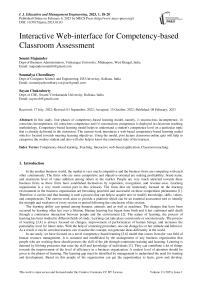Interactive Web-interface for Competency-based Classroom Assessment
Автор: Soumi Majumder, Soumalya Chowdhury, Sayan Chakraborty
Журнал: International Journal of Education and Management Engineering @ijeme
Статья в выпуске: 1 vol.13, 2023 года.
Бесплатный доступ
In this study, four phases of competency-based learning model, namely, i) unconscious incompetence, ii) conscious incompetence, iii) conscious competence and iv) unconscious competence is deployed in classroom teaching methodology. Competency-based learning model helps to understand a student's competence level on a particular topic that is already delivered in the classroom. The current work introduces a web-based competency-based learning model which is focused towards meeting learning objectives. Using the model, post lecture classroom online quiz will help to categorize the weaker student and also will also help to know the emotional state of the learners.
Competency-based learning, Teaching, Interactive web-based application, Classroom teaching
Короткий адрес: https://sciup.org/15018585
IDR: 15018585 | DOI: 10.5815/ijeme.2023.01.03
Текст научной статьи Interactive Web-interface for Competency-based Classroom Assessment
In the modern business world, the market is very much competitive and the business firms are competing with each other continuously. The firms who are more competitive and objective-oriented are making profitability, brand name, and maximum level of value addition among others in the market. People are very much attracted towards these business firms as these firms have established themselves by reputation, recognition, and revenue-wise. Learning organization is a very much crucial part in this scenario. The firms that are immensely focused on the learning environment in the business organization are becoming powerful and successful on these competition phenomena [1]. Therefore, it can be said that learning is such a process that can help to acquire new or modify knowledge, skills, values, and competencies. The current work aims to provide a platform which can be an essential assessment tool to identify the strength and weakness of every session or period following the conclusion of the session.
The learning ability can spread among humans, animals, and as well as machines. The changes that have been occurred by learning often last over a lifetime. Human learning has begun from birth and it has continued until death through a continuous interaction between people and the environment [2]. The nature of learning, the process of learning has been studied in different fields of study. Learning can take place consciously or unconsciously. The process of learning [3,4] is always focused on changes, improvement of performances of human beings, and increases the potentiality level for future tasks. With the help of a learning procedure, one can change his or her attitude and behavior. As a result, it can be seen that learners can visualize the concept, can generate ideas differently in the world.
In our study, we have focused on a novel competency-based learning [5,6] model that comes from the vast field of human resource management. It is assumed and established by the management of any business organization that people who are working there should possess the skill of the job through continuous training and learning. Learning is denoted by lifelong processes that raise the skill and knowledge of individuals [3]. They can contribute a lot of things towards the improvement of the level of efficiency in a business organization. A modest level of attention should be given to the phases of learning. The learning gap must be identified by management to understand the need for training and development. Based on this people of the organization can get the opportunities to learn, grow and develop.
Employees are critical assets and always recognized by the most important human capital of the organizations. Therefore, learning model on competencies is the prime factor of every firm.
The learning model [7] has been applied in the area of competencies in the classroom teaching methodology. This competency-based learning model [8] has four phases, namely, i) unconscious incompetence, ii) conscious incompetence, iii) conscious competence and iv) unconscious competence. This competency-based learning model helps to understand a student's competence level [9] on a particular topic that is already delivered in the classroom. In this study, we have applied these four stages of the learning model to users, i.e., teachers and trainers [4]. They can easily evaluate and measure the level of understanding of a student on the delivered lecture topic.
The model-based system [10] has been designed for the interaction of teachers and students in the classroom. Like the understanding of employees' competencies in the organization, the model can be also implemented in classroom teaching methodology. This web-based interface [11] gives advantages to teachers about knowing the emotional state of the learners. The key motivation behind competency-based learning model is to provide competency-based education system so that the students can be more conscious [12,13] regarding their lessons and the concerned teacher can identify the outcome of each session with students. The approach is unique in nature due to its major focus towards student psychology and competency based [14,15] education, as the evaluation model directly identifies whether the student has actually managed to learn [15] anything during the session. The survey following each session can help to bridge the gap between weaker students with the learner, as well as the students who are more attentive in the class. The proposed competency-based learning model can be an essential and powerful tool [16,17] as it not only helps to evaluate the outcome of each session, but also helps to identify whether the teacher was actually able to connect with the students through their teaching-learning process.
The current work is organized as chapter 2 discusses various related works of this domain; in chapter 3 the learning model is discussed thoroughly. The proposed method is highlighted in chapter 4. Results are demonstrated in chapter 5 and discussed in Chapter 6. Paper concludes in chapter 7.
2. Literature Review
In 2020, Haryudo et al. designed competency test model using electrical installation automation. They tested the model [19] on students in which they used Cohhen 'kappa (κ) coefficient in order to establish inter-reliability agreement. In 2020, Combéfis et al. proposed a reinventing evaluation with competency based [10] assessments: a practical experiment with future computer science engineers. In this work, they presented a pedagogical device, supported by a tool, moving evaluations at the heart of the learning process. The pro-posed pedagogical device and associated developed tool were tested for during 2019-2020 academic year. It was implemented second-year bachelor to master computer science engineering students, on classrooms with between 17 and 34 people. Last year, in 2021, Dhahri et al. Was involved in Teachers’ Information and Communication [20] Technology (ICT) Assessment Tools. This work showed that using ICT Only, assessment tool can be enhanced accordingly. Cardone et al. used competence testing module. This tool was implemented under the pedagogical and methodological guidelines of the socio formative competencies approach. In that work, the results of an experience with a course of Formal Logic Programming of the Systems Engineering and Computer Science Program of the University of Quindío were presented.
There has been significant research done on the area of competency-based learning model, but to summarize most of the work were focused on assessment tool rather than psychological aspects related to the assessment. The research gap includes focusing on psychological aspects related to the assessment. Hence, the primary objective of the current work is to enhance the competency learning model used in this work is explained in the following section for further clarification.
3. Competency Learning Model
The four stages of competence are also known as the four stages of learning. It is based on a model of the learning experience. At the very beginning stage, the learners [21] are not aware of what they know or how much they are aware of things (subject topic in class-room). After that, they start to learn and move through the four psychological stages until they reach the final stage that is unconscious competence. The learning model of competence has four stages.
i) Unconscious incompetence: In the first level of the learning stage, it has been stated that learners are not aware of the knowledge or skill gap as per their understanding. They do not know that they are not well known about the topic of discussion that has been delivered by the teacher in the classroom. This level is denoted as unconscious incompetence.
ii) Conscious incompetence: In the next stage of the learning model, the learner comes to know about the unawareness of existing skills and knowledge gaps. Again, learners understand the need of acquiring new skills and knowledge or proper understanding of the subject topic [7,8]. Learning begins in this second level of this model that is known as conscious incompetence.
iii) Conscious competence: In the third level of conscious competence, the learners are quite aware of using the acquired skills or concept of the topic and perform better as per understanding in classroom teaching procedure. They possess the thought of continuous practice and the importance of hard-working at the same level and start practicing on how to enhance knowledge related to the delivered lecture topic.
iv) Unconscious competence: The fourth and last stage of the competence learning model is unconscious competence where learners have enough experience with acquiring new and modified knowledge and can perform easily in an unconscious psychological state also [9].
4. Proposed Method
5. Result Analysis and Discussion
By understanding and implementing the learning model [22,23] in the web interface, a user or a trainer or a teacher can identify the learning needs better, and based on that they can establish learning objectives. In this case, their target audience (the students) will move with the four psychological stages related to the understanding of the given topic in a subject [6]. This web-based interface platform, we have applied to the teacher-student classroom teaching methodology.
In this work these four stages of the competency-based learning model has been implemented into the interactive web interface plat-form between students and teachers [9]. This will provide a proper understanding of the student knowledge gap to the teachers. Again, teachers can take corrective measures based [24,25] on the outcome of this system. In this pandemic time schools, colleges, and universities all are being stopped functionally and the entire teaching-learning method has come into the online or digital platform. To feel the importance of learning this web interface platform becomes very essential to evaluate students understanding capabilities [26] by teachers. As the teaching [27,28] has been conducted through using different online modes so that it is difficult to find out students’ acquired level knowledge regarding the lectured topic.
Most of the time students are not visible and audible due to connectivity problems. Teachers cannot understand whether their lecture session is being fruitful or not. This interactive system has made the evaluation process easy in this crisis time. This interactive web inter-face learning system [29,30] has given options for every asked question. As per understanding the students will provide the answers. Again, the answers’ will be evaluated [31] against the correct answers that have been already incorporated into this learning system. In this way, the entire user-friendly system is performing effectively. There is no need to say that it has not made ease the teaching-learning session [32,33] digitally as well as it has huge affectivity in physical classroom teaching. The trainer or teacher will very much focus on the students’ competence level, which means in which stage the student stands among these four competency-based learning stages. This assessment of students' competencies [19] will pro-vide the idea towards solutions that how poor can be average, the average can be good, good can be better, and better can be best in classroom teaching method. In this way based on the evaluation through this interface, the solutions can be made easily and efficiently in learning [34,35].

Fig. 1. Block Diagram of the proposed Method
As shown in Fig. 1, the proposed system can be mainly categorized into two parts: Admin panel and User panel. Following logging into the web interface [36] Admin can create quiz, which will be forwarded to the user. User [37,38] can take the test, select the answers and based on the user’s answers competency level will be tested. Meanwhile admin can Edit or delete the quiz, can add questions in the quiz, edit or delete them, as shown in Figure 1. On the other hand, while answering every question, user must select their competency level based on the question and user’s knowledge of the same. Finally, after answering all the questions, user can exit the test. In the meantime, user can also check competency level.
In order to conduct the experimental study, a web portal [38,39] was developed through which the competencebased assessment tool was implemented. The website was created using: JavaScript at the backend and HTML 4, CSS3 at the frontend.
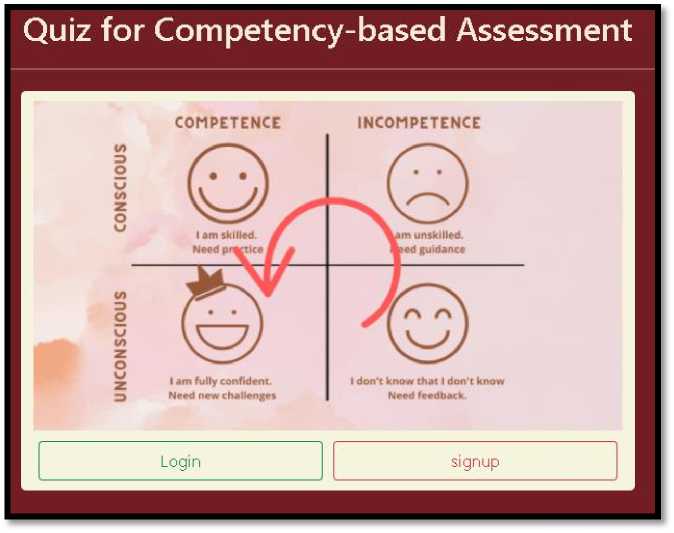
Fig. 2. Home page for competency-based classroom assessment
Fig. 2. Shows the sign-in page for competency-based classroom assessment. As it can be seen there are four possible cases (as dis-cussed earlier in Section 3). Fig. 3. reported the question creation pages from admin panel (number of questions, timer and subject can be selected). After question setting a sharable quiz link (get quiz link) can be created which can be distributed amongst the students after class. Post lecture student can join the quiz (fig 3) and attempt the quiz (mouse hover selector is used). After answering each question students will have to select any one the 4 competency-level to proceed to the next question (Fig. 4.).
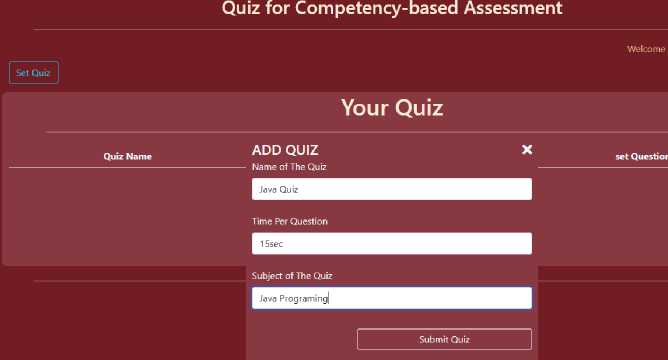
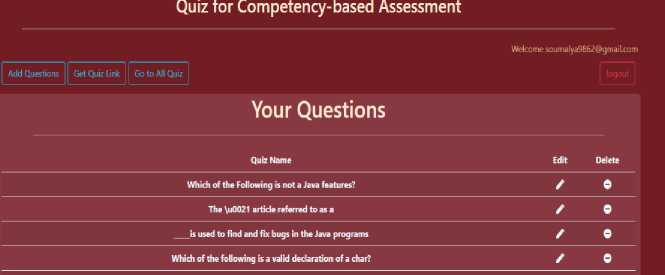
Fig. 3. Quiz setting page and get quiz link
End of the quiz student can see their obtained marks and the competency-level (Fig. 3). If the selection is unconscious [39-41] incompetence but answer is correct or if the selection is unconscious competence but response is incorrect the response will not be counted.
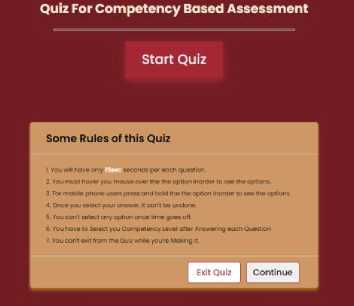
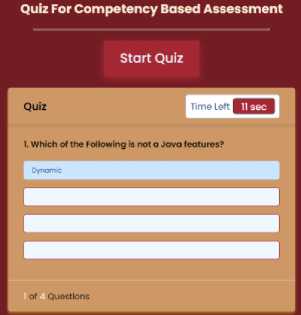
Start quiz
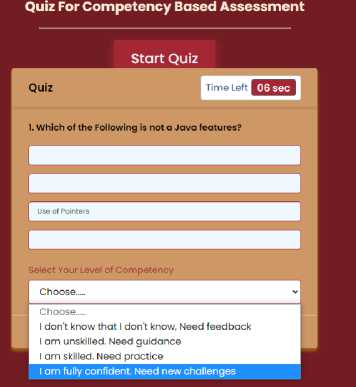
Fig. 4. User interface of the competency model
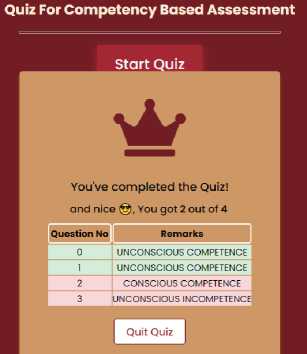
Selection of competency-level and final results
Fig 4 shows the interface of the model and final results dialog. Fig. 5 reported the competency matrix [17] and shows the % of students of each competency in the classroom, based on the analysis depicted in Table 1. Depending upon the competency matrix class teacher can assess the understanding levels of the student in this class and accordingly the teacher can change the teaching methodology. This application can be helpful for both online and offline mode teaching to understand the student’s engagement in the class and teacher can also get feedback after each class. Therefore, decisions can be taken based on the feedback.
Table 1. Obtained results from student’s competency assessment at different stage.
|
Question No. |
Unconscious Incompetence |
Conscious Incompetence |
Conscious Competence |
Unconscious competence |
|
1 |
3 |
15 |
26 |
9 |
|
2 |
8 |
16 |
11 |
8 |
|
3 |
4 |
11 |
21 |
5 |
|
4 |
9 |
14 |
11 |
4 |
|
5 |
5 |
8 |
9 |
4 |
|
6 |
1 |
14 |
9 |
3 |
|
7 |
6 |
11 |
10 |
4 |
|
8 |
5 |
13 |
7 |
3 |
|
9 |
4 |
16 |
5 |
2 |
|
10 |
7 |
6 |
12 |
4 |
|
11 |
4 |
10 |
8 |
5 |
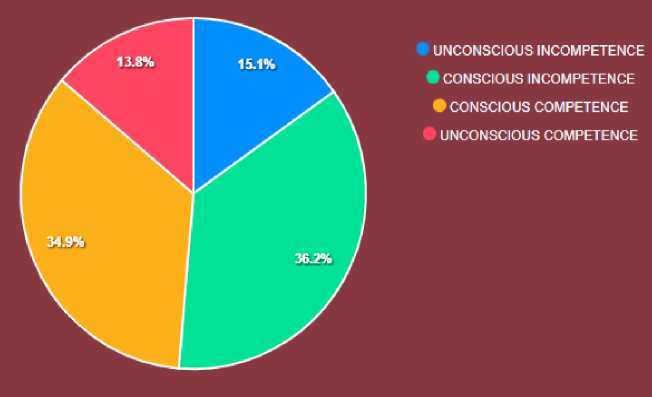
Fig. 5. Competency of students in each level
As discussed previously, admin can create the quiz and user can ap-pear for the test. As shown in Figure 6, user can select his/her competency level while answer any question from the quiz. The admin can add/edit/delete questions from the quiz. Following the answering procedure of the user, user will be able to visualize bar chart, pie chart from his last quiz session
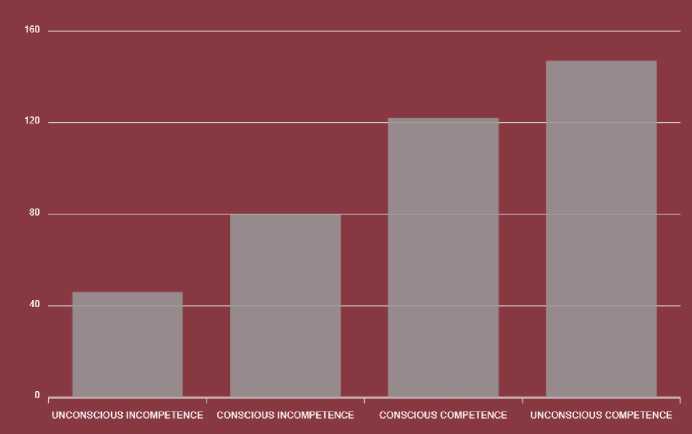
Fig. 6. Bar Chart explaining the Competency Matrix
To thoroughly analyze the system, a survey was conducted after a session of Basic Computer Subject at JIS University, Kolkata. In this survey total 395 responses of students of Computer Science and Engineering were recorded. The participants belonged to age group ranging from 18-25 years and the male and female ratio were 3:1. As shown in Fig. 4, out of those 395 responses 147 responses were found to be unconscious competence, 122 responses were marked as conscious competence; 80 responses were identified as conscious in-competence and rest of the 46 responses were identified as unconscious incompetence.
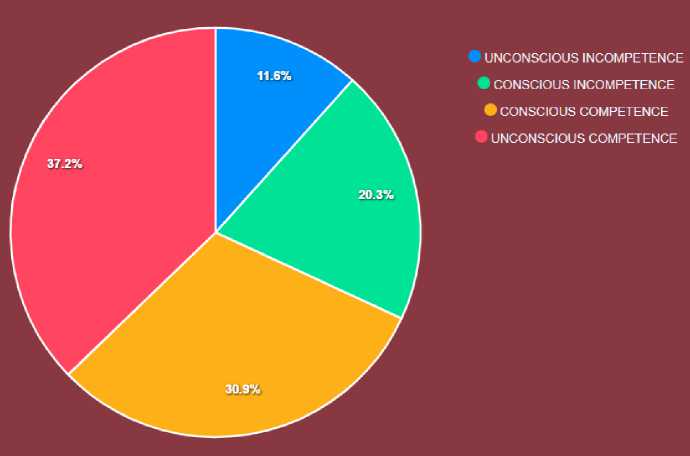
Fig. 7. Pie Chart explaining the Competency Matrix
As shown in Figure 7 the level of Unconscious competence was high-er in this case study, which means the learners have acquired enough experience previously from new and modified knowledge [42,43] and can solve the problem statement given in the class in an unconscious psychological state as well.
6. Discussion
The competency-based learning asks for making the decision on which competences need further evidence, the mandatory list of corresponding competence-based [11] assessment tests is presented to the learner. The teacher is able to set the questions manually, but how much relevant the questions are to the topic of the session, is still not evaluated by the system or rather it can’t be evaluated as the process is manual (As shown in Figure 4). Although the classification of competencies and connecting them with student’s consciousness focusses more light on the outcome [44] of the session for each and every student, or rather for the whole class/audience. A teacher’s aim is always to educate the student through their teaching-learning system [45] and the success of that can be evaluated only through a proper assessment tool. The current competency [18] based learning model provides deep insight knowledge beyond the existing assessment tools’ analysis. (As shown in Fig. 6; Table 1 and Fig. 7). The four different classes not only highlight the success rate of the evaluation, but also shades light upon the teacher’s connectivity with the student.
The major concern and weakness of the model [27] is directly related to the logistical organization [28] for the allocation of evaluations slots with instructors and for the provision of enough assessments to at least cover the basic competencies.
7. Conclusion
If someone does not know the concept of a topic or can’t under-stand it properly, he or she will be less engaged towards the subject. This should not be the correct practice of classroom teaching or it can say it cannot make a solution at all. On the other hand, if some-one has got a clear vision about the fundamental concept of the topic, he or she will be more engaged towards the lecture. Their learning curve will go up. In this scenario, it should be considered that a classroom is occupied by students of different merit and different categories, i.e., very good, good, average, poor, etc. Therefore, every student needs to enhance themselves through proper learning skills for gaining a better future in life. These four stages of the learning model are used in adaptive learning technologies. To know in which stage a learner possesses for a particular topic, an adaptive learning platform can choose with option about the content on the delivered topic. The current framework aims to make easy understanding for learners to reach the next level of learning. This interactive web interface platform helps to assess learners and will identify the skill gaps and make a solution to move from stage one to the next stages as soon as possible. Future work may con-sists of experimenting on the existing features or adding new features in the assessment tool. Future study may also consist of comparative analysis between other similar assessment tool available. Although the sole purpose of the study was to build a system that can focus mainly on identifying the competency of the audience. The study can be furthermore extended by using the system on other applications or case studies to further explore the feasibility of the system, as the system is still pilot in nature.
Список литературы Interactive Web-interface for Competency-based Classroom Assessment
- Taylor, E. W. (1994). A learning model for becoming interculturally competent. International journal of intercultural relations, 18(3), 389-408.
- Pentury, H. J., & Anggraeni, A. D. (2019). Enriching Teachers’ Pedagogical Strategy using the Role of Global Competence Learning Model. Jurnal Pendidikan Progresif, 9(1), 29-39.
- Efendi, R., Jama, J., & Yulastri, A. (2019, November). Development of Competency Based Learning Model in Learning Computer Networks. In Journal of Physics: Conference Series (Vol. 1387, No. 1, p. 012109). IOP Publishing.
- Hayward, L. M., & Charrette, A. L. (2012). Integrating cultural competence and core values: An international service-learning model. Journal of Physical Therapy Education, 26(1), 78-89.
- Taylor, E. W. (1993). A learning model of becoming interculturally competent: A transformative process (Doctoral dissertation, University of Georgia).
- Hattinger, M., & Eriksson, K. (2020, January). Mind the gap: A collaborative competence e-learning model between university and industry. In Proceedings of the 53rd Hawaii International Conference on System Sciences.
- Wannapiroon, P. (2014). Development of research-based blended learning model to enhance graduate students’ research competency and critical think-ing skills. Procedia-Social and behavioral sciences, 136, 486-490.
- Deejring, K. (2014). The design of a web-based learning model using collaborative learning techniques and a scaffolding system to enhance learners’ competency in higher education. Procedia-Social and Behavioral Sciences, 116, 436-441.
- Lee, M. H., Meng, Q., & Chao, F. (2007). Staged competence learning in developmental robotics. Adaptive Behavior, 15(3), 241-255.
- Combefis, S.; Moffarts, G.D.; (2020). Reinventing Evaluations with Competency Based Assessments: a Practical Experiment with Future Computer Science Engineers. 2020 IEEE Frontiers in Education Conference (FIE), (), –. doi:10.1109/fie44824.2020.9274207
- Ilahi, M., Cheniti-Belcadhi, L., & Braham, R. (2014). Scenario Model for Competence-Based Assessment. 2014 IEEE 14th International Conference on Advanced Learning Technologies. doi:10.1109/icalt.2014.103
- Evans, Jeffrey J.; Garcia, Esteban; Smith, Michael; Van Epps, Amy; Fosmire, Michael; Matei, Sorin (2015). [IEEE 2015 IEEE Frontiers in Education Conference (FIE) - Camino Real El Paso, El Paso, TX, USA (2015.10.21-2015.10.24)] 2015 IEEE Frontiers in Education Conference (FIE) - An assessment architecture for competency-based learning: Version 1.0. , (), 1–7. doi:10.1109/FIE.2015.7344340
- Mammi, Hazinah K.; Ithnin, Norafida (2012). [IEEE 2012 IEEE International Conference on Teaching, Assessment and Learning for Engineering (TALE) - Hong Kong, China (2012.08.20-2012.08.23)] Proceedings of IEEE International Conference on Teaching, Assessment, and Learning for Engineering (TALE) 2012 - Competency-based education (CBE) for IT security: towards bridging the gap. , (), W2A-15–W2A-16. doi:10.1109/tale.2012.6360293
- Beatriz, E.; Florian, G.; Baldiris, Silvia M.; Fabregat, Ramon (2010). [IEEE IEEE EDUCON 2010 Conference - Madrid, Spain (2010.04.14-2010.04.16)] IEEE EDUCON 2010 Conference - A new competency-based e-assessment data model: Implementing the AEEA proposal. , (), 473–480. doi:10.1109/educon.2010.5492538
- Mammi, H. K.; Ithnin, No. (2012). Competency based Education (CBE) for IT Security: Towards Bridging the Gap. International Journal of Engineering Pedagogy (iJEP), 2(4), doi:10.3991/ijep.v2i4.2268
- Ilahi, M.; Cheniti Belcadhi, L.; Braham, R. (2013). Towards a Competence Web -Based Assessment model to support lifelong learning. [IEEE 2013 Fourth International Conference on Information and Communication Technology and Accessibility (ICTA) - Hammamet, Tunisia (2013.10.24-2013.10.26)] Fourth International Conference on Information and Communication Technology and Accessibility (ICTA) - 1–6. doi:10.1109/ICTA.2013.6815286
- Franklin, N.; Melville, P.(2015). Competency assessment tools: An exploration of the pedagogical issues facing competency assessment for nurses in the clinical environment. Collegian, 22(1), 25–31. doi:10.1016/j.colegn.2013.10.005
- Russo, D. (2016). Competency Measurement Model. European Conference on Quality in Official Statistics (Q2016) Madrid, 31 May-3June 2016
- Rahman, A.; Hanafi, N.; Mukhtar, M.; Ahmad, J. (2014). Assessment Practices for Competency based Education and Training in Vocational College, Malaysia. Procedia - Social and Behavioral Sciences. 112. 1070-1076. 10.1016/j.sbspro.2014.01.1271.
- Haryudo, S.; Ekohariadi, E.; Munoto, M.; Wibawa, S; Achmad, F.; Sulistyo, E.. (2020). Design of Competency Test Model for Electrical Installation Automation Based Project Learning for Electrical Engineering Students. 1-5. 10.1109/ICVEE50212.2020.9243271.
- Dhahri, M. and Koutheair Khribi, M. (2021) Teachers’ Information and Communication Technology (ICT) Assessment Tools: A Review. 2021 International Conference on Advanced Learning Technologies (ICALT), 2021, pp. 56-60, doi: 10.1109/ICALT52272.2021.00025.
- Garay-Rondero, C. L., Calvo, E. Z. R., & Salinas-Navarro, D. E. (2019). Developing and Assessing Engineering Competencies at Experiential Learning Spaces. 2019 IEEE Frontiers in Education Conference (FIE). doi:10.1109/fie43999.2019.9028355
- Oda, S.; Inoue, M.; Yamazaki, A. K. (2017). [IEEE 2017 7th World Engineering Education Forum (WEEF) - Kuala Lumpur (2017.11.13-2017.11.16)] 2017 7th World Engineering Education Forum (WEEF) - Assessment of Global Competency for Engineering Students in a Multicultural and Multidisciplinary Project Based Learning Course., 439–443. doi:10.1109/WEEF.2017.8467071
- Combéfis, S. and Van Den Schrieck, V. (2021) Transforming a Course with a Traditional Evaluation into a Competency-Based Assessment Approach: a Practical Experiment, 2021 IEEE Frontiers in Education Conference (FIE), pp. 1-5, doi: 10.1109/FIE49875.2021.9637229.
- Combéfis, S. (2021) A COVID-19 Teaching Experiment: Combining Competency-Based Assessment and Micro-Courses to Teach Technical and Non-Technical Skills, 2021 IEEE Frontiers in Education Conference (FIE), 2021, pp. 1-5, doi: 10.1109/FIE49875.2021.9637126.
- Hung, B.K.H., Wen, J.F., To, C.C.N., Tang, J.S.M. (2022). Competency-Based Workplace Learning and Assessment: A Framework and Models for Future Research. In: Hong, C., Ma, W.W.K. (eds) Applied Degree Education and the Future of Learning. Lecture Notes in Educational Technology. Springer, Singapore. https://doi.org/10.1007/978-981-16-9812-5_7
- Elliott, G. (2001). An Alternative Model of Competence-Based Assessment. In: Velde, C. (eds) International Perspectives on Competence in the Workplace. Springer, Dordrecht. https://doi.org/10.1007/978-94-010-0742-9_6
- Gupta, P., Shah, D. & Singh, T. (2021) Competency-Based Assessment in Pediatrics for the New Undergraduate Curriculum. Indian Pediatr 58, 775–779. https://doi.org/10.1007/s13312-021-2290-7
- Bureš, V., Tučník, P., Mikulecký, P., Mls, K., & Blecha, P. (2016). Application of ambient intelligence in educational institutions: Visions and architectures. International Journal of Ambient Computing and Intelligence (IJACI), 7(1), 94-120.
- Börner, D., Kalz, M., & Specht, M. (2013). Closer to you: Reviewing the application, design, and evaluation of ambient displays. International Journal of Ambient Computing and Intelligence (IJACI), 5(3), 16-31.
- Babo, R., Dey, N., & Ashour, A. S. (Eds.). (2021). Workgroups E-Assessment: Planning, Implementing and Analyzing Frameworks. Springer Singapore.
- Dey, N., Mishra, R., Fong, S. J., Santosh, K. C., Tan, S., & Crespo, R. G. (2020). COVID-19: psychological and psychosocial impact, fear, and passion. Digital Government: Research and Practice, 2(1), 1-4.
- Sudha, M. R., Sriraghav, K., Jacob, S. G., & Manisha, S. (2017). Approaches and applications of virtual reality and gesture recognition: A review. International Journal of Ambient Computing and Intelligence (IJACI), 8(4), 1-18.
- Odella, F. (2016). Technology studies and the sociological debate on monitoring of social interactions. International Journal of Ambient Computing and Intelligence (IJACI), 7(1), 1-26.
- Hyndman, J., Lunney, T., & Mc Kevitt, P. (2011). AmbiLearn: Multimodal assisted learning. International Journal of Ambient Computing and Intelligence (IJACI), 3(1), 53-59.
- Bhatia, S., Chaudhary, P., & Dey, N. (2020). Opinion mining in information retrieval. Springer Singapore.
- Mishra, D. K., Dey, N., Deora, B. S., & Joshi, A. (Eds.). (2020). ICT for Competitive Strategies: Proceedings of 4th International Conference on Information and Communication Technology for Competitive Strategies (ICTCS 2019), December 13th-14th, 2019, Udaipur, India. CRC Press.
- Fong, S., Dey, N., & Joshi, A. (2020). ICT Analysis and Applications. Proceedings of ICT4SD, 2.
- Kale, G. V., & Patil, V. H. (2016). A study of vision based human motion recognition and analysis. International Journal of Ambient Computing and Intelligence (IJACI), 7(2), 75-92.
- Ali, M. N. Y., Sarowar, M. G., Rahman, M. L., Chaki, J., Dey, N., & Tavares, J. M. R. (2019). Adam deep learning with SOM for human sentiment classification. International Journal of Ambient Computing and Intelligence (IJACI), 10(3), 92-116.
- Zohora, S. E., Khan, A. M., Srivastava, A. K., Nguyen, N. G., & Dey, N. (2016). A study of the state of the art in synthetic emotional intelligence in affective computing. International Journal of Synthetic Emotions (IJSE), 7(1), 1-12.
- Zamkah, A., Hui, T., Andrews, S., Dey, N., Shi, F., & Sherratt, R. S. (2020). Identification of suitable biomarkers for stress and emotion detection for future personal affective wearable sensors. Biosensors, 10(4), 40.
- Wu, Q., Dey, N., Shi, F., Crespo, R. G., & Sherratt, R. S. (2021). Emotion classification on eye-tracking and electroencephalograph fused signals employing deep gradient neural networks. Applied Soft Computing, 110, 107752.
- Yang, N., Dey, N., Sherratt, R. S., & Shi, F. (2020). Recognize basic emotional statesin speech by machine learning techniques using mel-frequency cepstral coefficient features. Journal of Intelligent & Fuzzy Systems, 39(2), 1925-1936.
- Sánchez-Prieto, J. ; Cruz-Benito, J. ; Therón, R. ; García-Peñalvo, F. (2020). Assessed by Machines: Development of a TAM-Based Tool to Measure AI-based Assessment Acceptance Among Students. International Journal of Interactive Multimedia and Artificial Intelligence. 6. 80-86. 10.9781/ijimai.2020.11.009.

